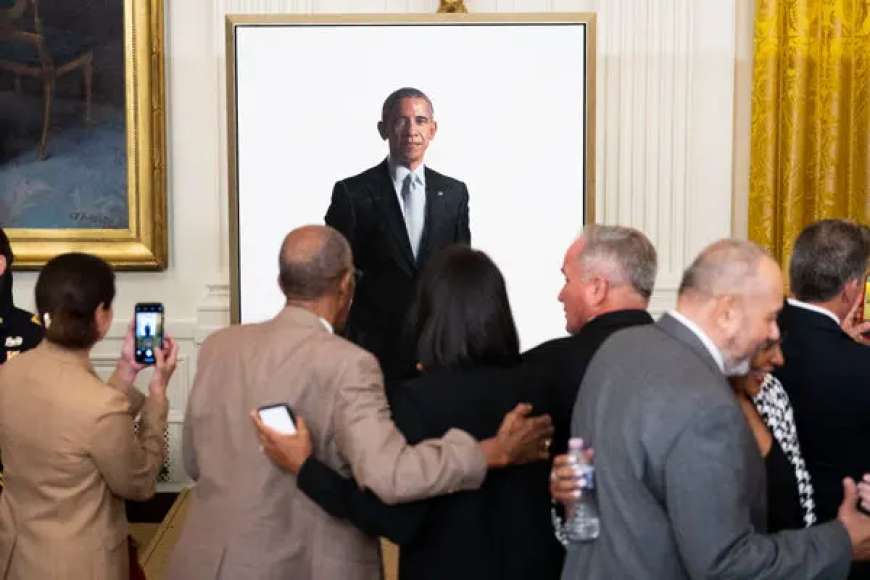Trump Shoves Obama Portrait Behind Closed Doors in White House Redecorating Shake-Up
President Donald Trump has moved Barack Obama’s official White House portrait from a prominent location to a hidden stairwell, breaking with decades of tradition. The move has sparked political debate over presidential protocol.

Washington, D.C. — In a move that has reignited political tensions in the nation’s capital, President Donald Trump has reportedly ordered the relocation of former President Barack Obama’s official White House portrait to a secluded stairwell, a decision that many historians and political observers are calling another breach of longstanding presidential protocol.
The portrait, unveiled in 2012 during Obama’s tenure, has been a fixture in a prominent location within the White House’s Grand Foyer for over a decade. Traditionally, official presidential portraits are displayed in high-traffic areas as a sign of respect for predecessors, regardless of political differences. However, according to multiple sources familiar with White House operations, the Obama portrait was quietly moved last week to an obscure corner along a restricted service staircase used primarily by staff — far from the eyes of the public and visiting dignitaries.
A Departure from Presidential Tradition
The presidential portrait tradition is more than ceremonial; it is symbolic. It serves as a visual reminder of the peaceful transfer of power and the enduring nature of American democracy. Political disagreements have historically been set aside when it comes to preserving this tradition, with presidents honoring the legacies of those who came before them.
Trump’s decision marks the second time during his non-consecutive presidency that he has disrupted these norms. During his first term, he broke with tradition by delaying the official portrait unveiling for Barack and Michelle Obama, an event typically hosted by the succeeding president. Instead, the ceremony took place under President Joe Biden in 2022.
Now, just months into his return to office, Trump’s relocation of Obama’s portrait is being viewed by critics as a deliberate political message rather than an administrative change.
Reactions from Political Circles
The move has sparked sharp reactions across the political spectrum. Former Obama White House staffers expressed disappointment, with one senior aide calling the decision “petty and unnecessary.” Democratic lawmakers have accused Trump of using symbolic gestures to inflame partisan divides rather than foster unity.
Republican allies of the president, however, defended the decision, arguing that the White House is “his to arrange” and that past administrations have also made adjustments to the placement of portraits and artifacts.
While the Trump administration has not released an official statement regarding the change, several aides speaking off the record suggested that the move was intended to make space for new artworks highlighting “America’s founding heritage.”
A Pattern of Protocol Breaks
Observers note that this is not an isolated incident. Trump’s presidency — both in his first term and now — has been marked by multiple deviations from presidential norms, from unconventional Cabinet appointments to abrupt foreign policy announcements.
Moving a predecessor’s portrait to a little-seen location may seem small compared to major legislative decisions, but White House historians stress that such gestures carry symbolic weight. The placement of portraits communicates a message not only to the American people but also to visiting leaders, scholars, and future generations who view the White House as a living museum of U.S. history.
As presidential historian Douglas Brinkley explained in a 2020 interview, “The art and artifacts in the White House are not just decoration — they are carefully curated symbols of America’s political lineage. When a sitting president alters that without explanation, it sends a signal.”
The Bigger Picture
The portrait relocation comes amid broader political friction between Trump and the Obama political legacy. In recent weeks, Trump has been outspoken in reversing several Obama-era policies, from environmental regulations to international diplomacy agreements. This latest move — while seemingly symbolic — adds another layer to their long-running political rivalry.
For visitors, the change will be subtle yet noticeable. Tour guides often highlight presidential portraits as part of the White House experience, but the Obama portrait’s new location is in an area generally inaccessible to the public.
Whether this decision will remain permanent or be reversed in the future remains uncertain. What is clear is that, in the Trump era, even the placement of a painting can become a headline-making political statement.









